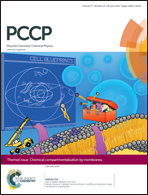Dynamics of single polyelectrolyte chains in salt-free dilute solutions investigated by analytical ultracentrifugation†
Abstract
The dynamics of polyelectrolytes in salt-free solution is an unsolved problem. We have investigated the sedimentation and diffusion of xanthan and poly(N-methyl 4-vinyl pyridine iodide) (P4VPI) in salt-free dilute solutions by analytical ultracentrifugation (AUC) using sedimentation velocity (SV) as a function of polyelectrolyte concentration (Cp). Our study reveals two concentration regimes distinguished in either polyanion (xanthan) or polycation (P4VPI) dilute aqueous solution. When Cp is below the Debye concentration (Cd) at which the chain separation (d) is close to the debye length (lD), the interchain electrostatic repulsion is negligible, and the reciprocal apparent sedimentation coefficient (1/s), apparent diffusion coefficient (D) or reciprocal apparent molecular weight (1/Mw) is linearly related to Cp. In the range Cp > Cd with d < lD, the interchain electrostatic repulsion is present, and the dynamics of polyelectrolytes becomes complex. The real sedimentation coefficient (s0), the diffusion coefficient (D0) and the molecular weight (Mw,0) of the single polyelectrolyte chain in salt-free dilute solution can be obtained by extrapolating the concentration to zero. The present study reveals that the complex dynamics of polyelectrolytes in salt-free dilute solutions arises due to the interchain electrostatic repulsion.


 Please wait while we load your content...
Please wait while we load your content...